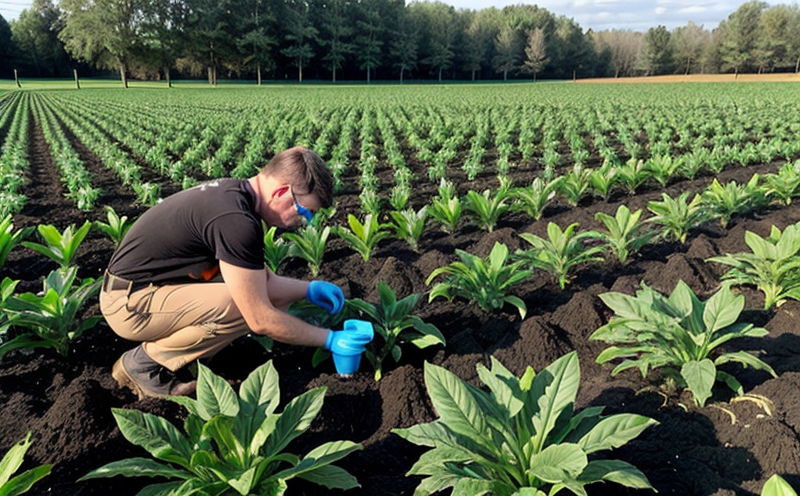Fertilizer Hygroscopicity Testing
Hygroscopicity testing plays a critical role in ensuring the quality and performance of fertilizers. This service involves assessing how much water a fertilizer sample can absorb, which is essential for maintaining its integrity during storage and transport. The test ensures that fertilizers remain effective by preventing excessive moisture from affecting their nutrient content or causing degradation.
Understanding hygroscopicity in fertilizers helps quality managers and compliance officers ensure product consistency across batches. R&D engineers rely on this data to optimize formulations, while procurement teams use it to select suppliers who adhere to stringent quality standards. Proper testing not only enhances the performance of agricultural products but also supports sustainable practices by minimizing waste.
The test method measures how much water is absorbed when a fertilizer sample is exposed to controlled humidity conditions over time. The amount of moisture absorbed indicates the hygroscopicity level, which can influence storage stability and nutrient availability in soil. Excessive absorption can lead to caking or clumping, reducing the effectiveness of granulated fertilizers.
For accurate testing, specimens are prepared by taking representative samples from bulk materials. These samples are then placed into controlled humidity chambers where they are exposed to varying levels of relative humidity for specified durations. The weight gain of each sample is measured periodically to calculate the hygroscopicity index.
The use of precise instrumentation such as balances and humidity chambers ensures reliable results, which are reported in terms of percentage moisture absorbed per unit mass over time. This data helps stakeholders make informed decisions about product handling, storage conditions, and potential adjustments to formulations based on observed trends.
International standards like ISO 19236 provide guidelines for conducting these tests accurately, ensuring that results can be compared across different laboratories globally. By adhering to such standards, testing services contribute to the overall quality assurance framework within the agricultural sector.
| Applied Standards |
|---|
| ISO 19236: Fertilizers — Determination of hygroscopicity index |
| ASTM D4580-17: Standard Test Method for Hygroscopicity and Swell Ratio of Plastic Powders and Bulk Solids |
| Use Cases and Application Examples |
|---|
| Determining optimal storage conditions to prevent fertilizer degradation. |
| Optimizing fertilizer formulations for improved performance under varying environmental conditions. |
| Ensuring compliance with international regulations regarding fertilizer quality. |
| Supporting research and development efforts aimed at creating more effective fertilizers. |
Applied Standards
The following standards are commonly used for conducting fertilizer hygroscopicity tests:
- ISO 19236: Fertilizers — Determination of hygroscopicity index.
- ASTM D4580-17: Standard Test Method for Hygroscopicity and Swell Ratio of Plastic Powders and Bulk Solids.
These standards ensure that the testing process is standardized, leading to consistent and reliable results across different laboratories. Compliance with these guidelines helps maintain the integrity of the testing data and supports accurate decision-making processes within agricultural operations.
International Acceptance and Recognition
Fertilizer hygroscopicity tests are widely recognized in both developed and developing countries as a crucial component of quality control measures. Many international organizations, including FAO (Food and Agriculture Organization) and ISO, emphasize the importance of conducting such tests to ensure that fertilizers meet specified standards.
- Australia: The Australian Fertilizer Standards recognize hygroscopicity testing as essential for ensuring product quality.
- United States: ASTM standards are widely used in U.S. agricultural practices for assessing fertilizer properties, including hygroscopicity.
- European Union: EU directives mandate compliance with ISO and EN standards for various aspects of fertilizer production and testing.
The global acceptance of these tests underscores their significance in maintaining consistent quality across international markets. By adhering to these standards, laboratories contribute significantly to the reliability of agricultural inputs worldwide.
Use Cases and Application Examples
Fertilizer hygroscopicity testing serves several critical functions:
- Determining the optimal storage conditions for different types of fertilizers based on their hygroscopic properties.
- Assisting in the development of new fertilizer formulations that are more resistant to moisture absorption.
- Ensuring compliance with international regulations regarding fertilizer quality and safety.
- Supporting research projects focused on improving nutrient delivery efficiency in plants.
These tests also play a vital role in educating stakeholders about the importance of proper handling practices for fertilizers during transportation and storage. By understanding how much moisture is absorbed by different types of fertilizers, producers and distributors can make informed decisions that enhance product performance and environmental sustainability.
| Applied Standards |
|---|
| ISO 19236: Fertilizers — Determination of hygroscopicity index |
| ASTM D4580-17: Standard Test Method for Hygroscopicity and Swell Ratio of Plastic Powders and Bulk Solids |
| Use Cases and Application Examples |
|---|
| Determining the optimal storage conditions for different types of fertilizers based on their hygroscopic properties. |
| Assisting in the development of new fertilizer formulations that are more resistant to moisture absorption. |
| Ensuring compliance with international regulations regarding fertilizer quality and safety. |
| Supporting research projects focused on improving nutrient delivery efficiency in plants. |





